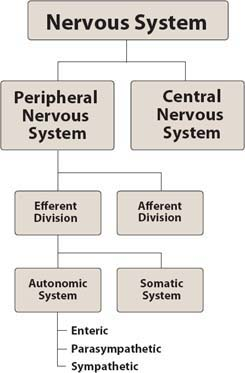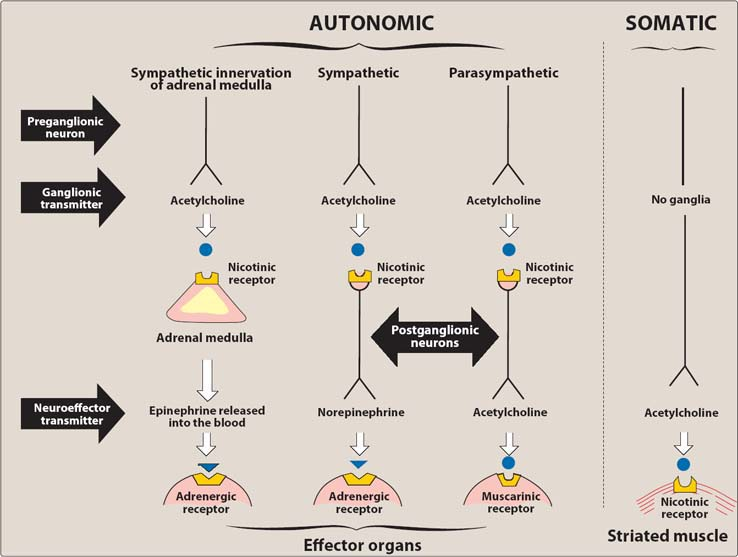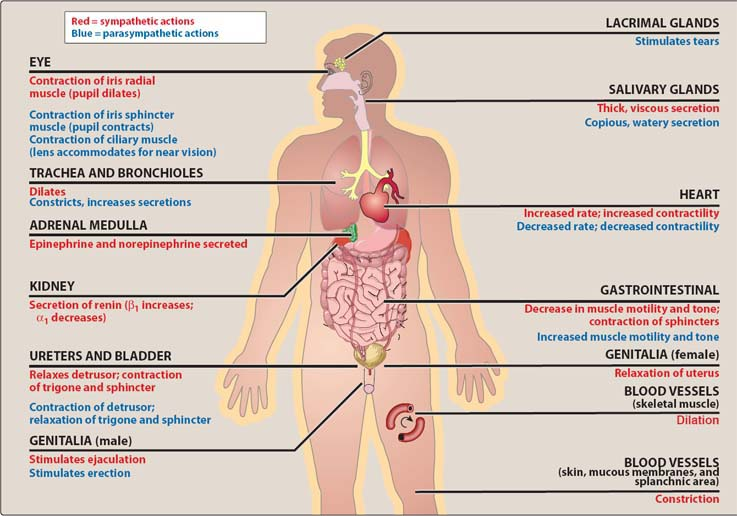Endocrine System
Sends signals to target tissues by varying the levels of bloodborne hormones
Nervous System

Exert its influence by the rapid transmission of electrical impulses over nerve fibers that terminate at effector cells
Effector cells
respond to the release of neuromediator substances.
What are autonomic drugs
Drugs that produce their primary therapeutic effects by mimicking or altering the function of the autonomic nervous system.
Either stimulate ANS or Block ANS
Nervous system is divided into how many anatomical divisions?
2; CNS (Central Nervous System) & PNS (Peripheral Nervous System)
What is the CNS
Composed of brain and spinal cords
What is the PNS
Its subdivided into:
efferent division- neurons of which carry signals away from brain and spinal cord of peripheral tissues
afferent- bring information from peripheral to CNS
It provides sensory imput to modulate function of efferent division through reflex arcs, or neural pathways that mediate a reflex action
Efferent portion of PNS is divided into 2 major functional subdivisions. What are they?
Somatic & Autonomic System
What is the Somatic system
thee somatic efferent neurons are involved in voluntary control of functions such as contraction of skeletal muscles essential for locomotion
What is the Autonomic system

regulates everyday requirements of vital bodily functions without the conscious participation of the mind
Because of the involuntary nature of the ANS, as well as its function, its also known as?
Visceral, Vegetative, or Involuntary Nervous System
ANS is composed of?

efferent neurons that innervate smooth muscle of the viscera, cardiac muscle, vasculature, and the exocrine glands; controlling digestion, cardiac output, blood flow, and glandular secretions
Anatomy of the ANS:
What are Efferent Neurons
ANS carries nerve impulses fromt he CNS to effector organs by 2 types of efferent neurons:
Preganglionic & Postganglionic
What are Preganglionic neurons?
Cell body located within CNS
Emerge from brainstem (spinal cord) and make a synaptic connection in ganglia (collection of nerve cell bodies located in PNS)
What are the functions of the ganglia
its a relay station between a preganglionic neuron and second nerve cell called Postganglionic
Collection of nerve cell bodies located in PNS)
What are Postganglionic neurons?
Cell body originating in Ganglion
Nonmyelinated & terminates on effector organs; ex. smooth muscles of viscera, cardiac muscle and exocrine glands
Anatomy of the ANS:
What are Afferent Neurons
They are important in the reflex regulation.
Ex: Sensing pressure in carotid sinus and aortic arch
Signals CNS to influence the efferent branch of the system to respond
Efferent ANS is divided into what 3 Nervous systems?
Sympathetic
Parasympathetic
Enteric
Anatomy of the Efferent ANS:
Sympathetic Neurons
Originate in CNS and emerge from 2 different spinal cord regions
Pregangionic neurons (short in comparison to Post) of Sympathetic system come from the thoracic & Lumbar region (T1-L2)
Synapse into 3 cord like chains of ganglia that run close to and in parallel on each side of the spinal cord.
Post gangionic nuerons extend from ganglia to tissues that innervate and regulate
Anatomy of the Efferent ANS:
The Sympathetic nervous system is also called the?
Thoracolumbar division (because of its location)
Anatomy of the Efferent ANS:
Describe the Preganglionic nerves ending of SNS
highly branched, enabling one pregangionic neuron to interact with many postganglionic neurons
Enables to activate numerous effector organs at the same time
(Adrenal medulla): receive preganglionic fibers from Sympathetic.
The adrenal medulla, in response to stimulation by ganglionic neurotransmitter acetylcholine, influences other organs by secreting the hormone epinphrine
lesser amounts of norepinpherine into the blood
Adrenal Medulla --> acetylcholine ---> epinephrine
Anatomy of the PNS:
Parasympathetic Neurons; where do they arise?
Arise from Cranial nerves:
III- oculomotor
VI- Facial
IX- Glossopharyngeal
X- Vagus
Sacral region (S2-S4)
Synapse in ganglia near or on the effector organ
Anatomy of the PNS:
Parasympathetic Neurons; Vagus Nerves
Accounts of 90% of preganglionic parasympathetic fibers in the body
Postgangionic from Vagus innervate most organs in thoracic & Abdominal Cavity
Anatomy of the Efferent ANS:
The Parasympathetic nervous system is also called the?
Craniosacral Division
Preganglionic fibers are longer and post gangionic are short with the ganglia close to or within the organ innervate
So Difference between Parasympathetic and Sympathetic Pre & Post ganglionic nerves?
Sympathetic: Pre = Short
Post = Longer as it extend from
ganglia to tissues that innervate and
regulate)
Para: Pre = Long
Post = Short with ganglia close to or
within organ innervate
Anatomy of the PNS:
Enteric Neurons
3rd division of ANS
Collection of nerve fibers that innervate the GI tract, pancreas, & gallbladder
"Brain of the gut"
Anatomy of the PNS:
Enteric Neurons function
functions independently of CNS & controls motility, exocrine and endocrine secretions, and microcirculation of GI tract.
Modulated (adapted) by both sympathetic & parasympathetic
Function of SNS
Adjust in response to stressful situation; fear, trauma, hypoglycemia, cold, & exercise
Sympathetic actions of SNS

Eye: Contract of Iris radial muscle (Pupil dilates)
Trachea & Bronchioles: Dilation
Adrenal Medulla: Secrete epinepherine & norepinephrine
Kidney: secrete renin (Beta increases Alpha decreases)
Ureters & Bladder: Relaxation of detrusor
Contract Trigone & Sphincter
Genitalia: Stimulate ejaculation
Salivary Glands: Thick, viscous secretion
Heart: Increase rate; increase contractility
GI: Decreased muscle motility and tone; contraction of sphincter
Genitalia (Female): Relax of uterus
Blood Vessel (Skeletal muscle): Dilation
Blood Vessels (Skin, mucous membranes, and splanchnic area): Constrict
Parasympathetic action of SNS

Eye: Contraction of Iris sphincter muscle (pupil contract) Contract of ciliary muscle (lens accomodate for near vision)
Trachea & Bronchioles: Constriction, increased secretions
Ureters & Bladder: Contraction of detrusor; relaxation of trigon sphincters
Genitalia (Male): Stimulate erection
Lacrimal Glands: Stimulate tears
Salivary glands: Copious, watery secretion
Heart: Decrease rate; decrease contractility
Gastrointestinal: Increase muscle motor & Tone:
Different Stimulations of Sympathetic & Parasympathetic
Sympathetic: "Fight or Flight" with sympathetic output (diffuses because postganglionic neurons may innervate more than one organ)
Parasympathetic: "Rest & Digest Stimulus" with parasympathetic output (discrete because postganglionic neurons are not branched, but are directed to a specific organ
Anabolic
Effects of stimulation of the sympathetic division
Output = increase HR & BP
mobilize energy stores of the body
increase blood flow to skeletal
muscles & heart while diverting
flow from skin & internal organs
Symapthetic "Flight or Flight"
Changes experienced by the body during emergencies:
triggered: direct sympathetic activation of effector by stimulation of adrenal medulla to release epinephrine & less norepinephrine
Function as a unit & often discharges as complete system; (ex. severe exercise/increase reaction to fear)
Helps body handle uncertain situations and unexpected stimuli
not essential for survival
Catabolic
stimulation of the parasympathetic division
Maintains homeostasis of body
maintains essential bodily functions; digestive process and elimination of wastes
required for life
acts to OPPOSE or balance actions of sympathetic division and is DOMINATE over sympathetic in "rest & digest situations"
not a functional entity and never discharges as a complete system. If did, massive, undesirable, and unpleasant symptoms (ex; involuntary urination & defecation
activated SEPARATE and system functions to affect specific organs; stomach or eye
Role of CNS in control of autonomic functions
does not require sensory input from peripheral structures to provide info on state of affairs in body
feedbacks are from afferent impulses, originating in viscera & other autonomic innervates that travel to CNS (hypothalamus, medulla oblongata, and spinal cord)
sends Efferent reflex impulses via Autonomic nervous system
Role of CNS: Reflex arcs
most afferent impulses are translated into reflex response w/o involving consciousness
Ex: Fall in blood pressure causes pressure-sensitive neurons (baroreceptors in heart, vena cava, aortic arch, and carotid sinus) to send fewer impulses to cardiovascular center in brain
It prompts a reflex response of icnrease sympathetic output to heart and vasculature and decrease parasympathetic output to the heart, results in rise in BP and tachcardia
Ex: An example would be a pinprick of the finger. The reflex arcs consist of an afferent (sensory) arm and an efferent (motor) arm
Emotions from ANS
Stimuli evokes strong feelings; rage, fear, pleasure, and can modify the activities of ANS
Innervations by ANS
Dual: most innervated by both divisions of ANS
Ex: Vagal parasympathetic = slows heart rate
Vagal Sympathetic = increase heart rate
one system usually predominates in controlling the activity of a given organ
Ex: heart, the vagus nerve is predominant factor for controlling rate
What organs ONLY receive sympathetic innervation?
adrenal medulla
kidney
pilomotor muscle
sweat glands
Somatic Nervous system
efferent somatic nervous system difference from autonomic in that single myelinated motor neuron from cns travels directly to skeletal w.o mediation of ganglia
Somatic nervous system is under voluntary control.
Autonomic nervous system is under involuntary control
Response in somatic are generally faster than ANS
Summary of differences between Sympathetic & Parasympathetic
Sympathetic Parasympathetic
widely distributed limited distrib
innervate all effectors circumscribed (1-1
broader influence interaction
synapse large number of anatomical arrangement
postganglionic fibers
Somatic Nervous system innervates:
skeletal muscles.
one somatic motor neuron axon is highly branched
each branch innervates a single muscle fiber (1 may intervate 100)
leads to formation of motor unit
when lack of ganglia and myelination of motor nerves, somatic nervous system enables a fast response
What are some Chemical Signalling between cells
Nuerotransmission in ANS
Hormones
local Mediators
Chemical Signalling between cells
Hormones
Specialized endocrine cells secrete hormones into bloodstream where they travel throughout body
exert effects to target cells in body
Chemical Signalling between cells
Local Mediators
most cells secrete chemicals that act locally; on cells in their immediate environment
these chemical signals are rapidly destroyed or removed, they do not enter blood and are not distributed throughout body
Histamine & Prostiglandins
Neurotransmitters
Distinct anatomic units with no structual continuity
communications between nerve cells and effector organs occur through release of specific chemical signals
How is release of neurotransmitters triggered?
Release of neurotransmitters is triggered by arrival of the action potential which
leads to depolarization.
An increase in calcium ion leads to fusion of synaptic vesicles with presynaptic membranes that release their content
It Rapidly defuses across cleft or space (synapse) moving cleft and expel neurotransmitters which
combine with specific receptors on postsynaptic
cell.
Membrane receptors of Nuerotransmitters
too hydrophilic to penetrate the lipid bilayers of target cell plasma membranes
signal than is mediated by binding to specific receptors on the cells surface of a target organ
what are the types of neurotransmitters (6)
Norepinephrine
acetylcholine
dopamine
seratonin,
histamine,
gama aminobutyric acid (GABA)
What 2 neurotransmitters are the primary chemical signals in ANS?
Acetylcholine & Norepinephrine
What are the neurotransmitters that are primary chemical signals of the CNS
dopamine
seratonin
histamine
gama aminobutyric acid (GABA)
Acetylcholine
ANS fibers can be divided into 2 groups based on chemical nature of neurotransmitter released
Its a ganglionic transmitter
If transmission by acetylcholine, the neuron is cholinergic
Cholinergic – autonomic nerve fibers which
transmission is mediated by acetylcholine. It mediates transmission of nerve impulses across autonomic ganglia in both sympathetic and
parasympathetic nervous systems
Acetylcholine continued
is the neurotransmitter for Adrenal medulla
Transmission from autonomic
postganglionic nerves to effector organs via
acetylcholine
Somatic nervous system is cholinergic
Norepinephrine & Epinephrine
when transmitted its adrenergic (another name for epinephrine)
Sympathetic system- norepinephrine mediates nerve impulses from autonomic postganglionic nerves to effector organs
Transmitters and Receptors:
Sympathetic innervation of adrenal medulla

Preganglionic transmitter: Acetylcholine
Ganglionic transmitter: Acetylcholine
Ganglionic receptor: Nicotrinic
Postganglionic transmission: Epinephrine
& Norepinephrine released in blood
Receptors in Postganglionic
Effector Organ: Adrenergic receptors
Transmitters and Receptors:
Sympathetic Nervous System
Preganglionic transmitter: Acetylcholine
Ganglionic transmitter: Acetylcholine
Ganglionic receptor: Nicotrinic
Postganglionic transmission: Norepinephrine
Receptors in Postganglionic
Effector Organ: Adrenergic receptors
Transmitters and Receptors:
Parasympathetic Nervous System
Preganglionic transmitter: Acetylcholine
Ganglionic transmitter: Acetylcholine
Ganglionic receptor: Nicotrinic
Postganglionic transmission: Acetylcholine
Receptors in Postganglionic
Effector Organ:
Muscarinic or Nicotinic receptors
Transmitters and Receptors:
Somatic Nervous System
No Ganglia
Acetylcholine dominated
Receptors in Postganglionic Effector Organ
Nicotinic receptor in striated muscle
All preganglionic fibers of the autonomic nervous system use the neurotransmitter ______________.
Acetylcholine
The major neurotransmitter for sympathetic
postganglionic fibers is __________________.
Norepinephrine
Stimulation of sympathetic innervation to the eye causes contraction of the ____________ muscle and, therefore, __________ of the pupil
Radial
dilate
The rate-limiting step in the synthesis of norepinephrine is ___________.
formation of DOPA by tyrosine b-hydroxylase
The major pathway for the termination of the action of norepinephrine is ______________
Its reuptake
The actions of acetylcholine released from parasympathetic fibers in viscera are mediated by _______ receptors.
Muscarinic
Adrenergic receptors in the heart are predominantly
______________.
beta 1
Stimulation of alpha 1 receptors causes predominantly ____________ of blood vessels.
Constriction
Stimulation of the sympathetic nervous system causes ___________ in gluconeogenesis and glycogenolysis.
An increase
Stimulation of the b2
receptor in the pregnant uterus causes ______________ of the smooth muscle.
relaxation
Baroreceptors maintain what?
Baroreceptors maintain normal blood pressure
by influencing SN and/or PSN